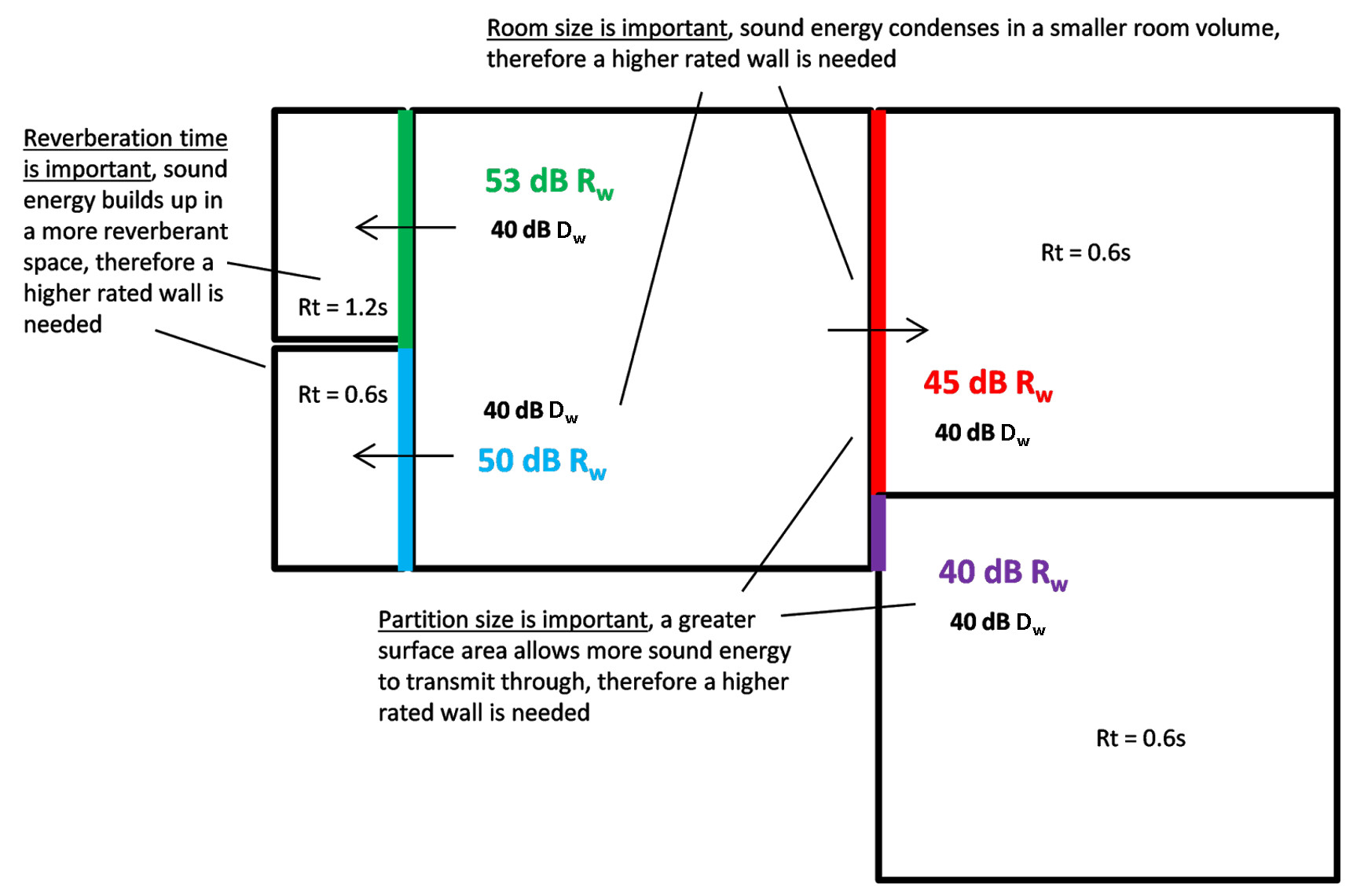Rw and Dw/DnTw in Acoustics - What do they mean?
Contents |
[edit] Introduction
The aim of this article is to shed some light on the 'dark art' of acoustics for clients and design teams, without going too far into the mathematics and every nitty-gritty technicality.
[edit] Dw
Dw is a term that relates to onsite sound insulation. It is as simple as the noise level in a source room, minus the noise level in a receiver room, the level difference. This is a performance standard, a value that can physically be measured on site after completion, and often has to demonstrate compliance with building regulations for schools and residential developments, and to achieve BREEAM credits.
The sound transmission between two rooms is the sum of many paths. The dominant and obvious path is directly through the separating partition. However, sound also transmits through junctions with the floor, soffit, facade and corridor wall. For example, if a wall is only built to the underside of a ceiling, and not to the slab, a significant flanking path exists around the wall. Flanking through mechanical ducts, services routes and penetrations and pipes and steels running between rooms also need to be considered. Flanking is particularly important in high-performance walls: the margin for error rapidly decreases around rooms such as music and performing arts spaces.
There are variations of Dw, for example BB93 and HTM specifies DnTw for schools and healthcare buildings. The nT in DnTw is the normalisation of reverberation, which allows us to compare sound insulation results objectively on a level playing field, irrespective of differences in reverberation.
Part E for residential uses DnTw + Ctr, the Ctr being a low-frequency correction, making this target more onerous than a DnTw. A Dw is also referred to in BREEAM documents for the performance targets of other building types, and is the term that most effectively follows the subjective level of sound insulation heard on site, though most standards will use the normalised version. The important thing to remember, is that these are all onsite performance targets.
Rw relates to the laboratory-rated sound reduction index of a single element, i.e. a wall. A laboratory test measures the wall performance in isolation from any other sound flanking paths. So, if a 50 dB Rw wall is built, in a perfect building with infinitely high mass surrounding constructions with no flanking whatsoever, it could theoretically achieve 50 dB Dw on site. But we cannot build perfect buildings and therefore we have to account for flanking. We also cannot guarantee that the Rw was determined correctly, or that the element tested in a lab was of a much different surface area to the actual element.
The important thing is, we need to choose walls, floors, glazing and doors with a sufficient Rw rating, and then build these well through good detailing and adequate workmanship, to achieve onsite Dw, DnTw, or DnTw + Ctr targets.
[edit] How to get from Dw to Rw
The same construction measured in a lab will get the same Rw result every time. But when measured on-site, the result will vary from room to room, project to project.
The calculation to convert from Rw to Dw has to account for:
- The area size of the separating partition, a bigger wall means more area of sound energy to transmit through. Bigger area = higher Rw.
- The volume of the 'receiving' room. The smaller the space, the great the concentration of sound energy, the higher the sound pressure level. Smaller volume = higher Rw.
- The reverberation time of the ‘receiving’ room, which is the time taken for sound to decay. A sports hall or church, with a large volume and hard reflective surfaces such as concrete or plasterboard, has a long reverberation time. A small space with lots of soft absorbent materials such as ceiling tiles, acoustic wall panels or soft furnishings, will have a low reverberation time. A high reverberation time means a build-up in noise levels from sound reflecting around the room, with energy being dissipated slowly from a lack of absorbent materials. Higher reverberation time = higher Rw.
- Account for potential flanking transmission on-site due to a potential downfall in construction quality or inattention in design to junction and penetrating detailing.
Therefore, it is not a simple case of Rw = Dw + X dB. The Rw can vary significantly between partitions, even if they require the same Dw. The image below shows this. If we look at DnTw, or DnTw + Ctr, theoretically the DnTw on site should not change with reverberation time (RT), as the nT refers to the normalisation of reverberation. The DnTw allows us to compare sound insulation results objectively on a level field, irrespective of reverberation. However calculation methods in standards like BB93 still use RT within the formula to calculate Rw from DnTw. The RT still effects the Dw, which is the true level difference, the one we subjectively hear on site!
[edit] How does this help with design?
The temptation by some consultants is to simply say 'Rw = Dw + 8 dB'. Why? This is a comfortable safety margin, and avoids the time-consuming exercise of measuring each wall, the volumes of each room and calculating the Rw.
So, what is wrong with this? Clearly, it can be seen from the illustration above that if the same wall type Rw (say 48 dB) is used everywhere where the Dw is 40 dB, there will be rooms that fail, as well as rooms that exceed the required performance standard by some distance. So, not only will there be walls in the building that fail and may require expensive remedial work, but there may also be unnecessary overspending on the walls that pass. If the worst case scenario is taken at 53 dB Rw and minimising the risk of failure, then most of the walls will be over designed.
Therefore, doing these calculations correctly, wall by wall, and paying close attention to the construction details, is important in achieving a successful, cost-effective design.
Of course, nobody wants to end up with 99 different wall types. But if the construction details are carefully designed, the number of plasterboard types is limited and all is conveyed clearly to the site team, safety margins can be cut down and only a handful of wall types actually used.
Reducing every dB of overdesign quickly adds up when applied over projects, schemes and larger frameworks, particularly those with common shared constructions. Clearly, getting things right in the first place cuts down on costly post-construction remedial work.
[edit] About this article
This article was written by ParkerJones Acoustics and is based on common questions the practice is asked by clients. It was posted in August 2019. ParkerJones Acoustics can be contacted through LinkedIn, the ParkerJones Acoustics website (opening October 2019), or emailing [email protected]
[edit] Related articles on Designing Buildings Wiki
- Acoustic consultant.
- Acoustic design for health and wellbeing.
- Airborne sound.
- Approved Document E.
- Ash deafening.
- Audio frequency.
- BREEAM Acoustic performance.
- Building Bulletin 93: acoustic design of schools.
- Building regulations.
- Decibel.
- Flanking sound.
- Impact sound.
- Noise nuisance.
- Pre-completion sound testing.
- Reverberation.
- Robust details certification scheme.
- Sound absorption.
- Sound insulation.
- Sound insulation in dwellings: Part 1: An introduction (GG 83-1).
- Sound reduction index (SRI).
- Sound v noise.
- Structure-borne sound.
- Suitably Qualified Acoustician.
Featured articles and news
Homes England supports Greencore Homes
42 new build affordable sustainable homes in Oxfordshire.
Zero carbon social housing: unlocking brownfield potential
Seven ZEDpod strategies for brownfield housing success.
CIOB report; a blueprint for SDGs and the built environment
Pairing the Sustainable Development Goals with projects.
Types, tests, standards and fires relating to external cladding
Brief descriptions with an extensive list of fires for review.
Latest Build UK Building Safety Regime explainer published
Key elements in one short, now updated document.
UKGBC launch the UK Climate Resilience Roadmap
First guidance of its kind on direct climate impacts for the built environment and how it can adapt.
CLC Health, Safety and Wellbeing Strategy 2025
Launched by the Minister for Industry to look at fatalities on site, improving mental health and other issues.
One of the most impressive Victorian architects. Book review.
Common Assessment Standard now with building safety
New CAS update now includes mandatory building safety questions.
RTPI leader to become new CIOB Chief Executive Officer
Dr Victoria Hills MRTPI, FICE to take over after Caroline Gumble’s departure.
Social and affordable housing, a long term plan for delivery
The “Delivering a Decade of Renewal for Social and Affordable Housing” strategy sets out future path.
A change to adoptive architecture
Effects of global weather warming on architectural detailing, material choice and human interaction.
The proposed publicly owned and backed subsidiary of Homes England, to facilitate new homes.
How big is the problem and what can we do to mitigate the effects?
Overheating guidance and tools for building designers
A number of cool guides to help with the heat.
The UK's Modern Industrial Strategy: A 10 year plan
Previous consultation criticism, current key elements and general support with some persisting reservations.
Building Safety Regulator reforms
New roles, new staff and a new fast track service pave the way for a single construction regulator.
























